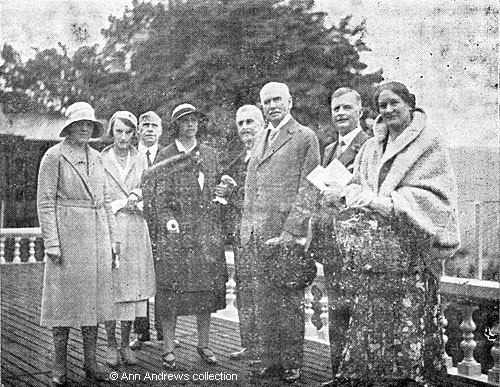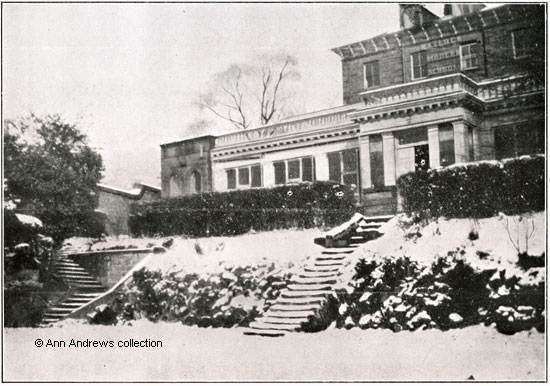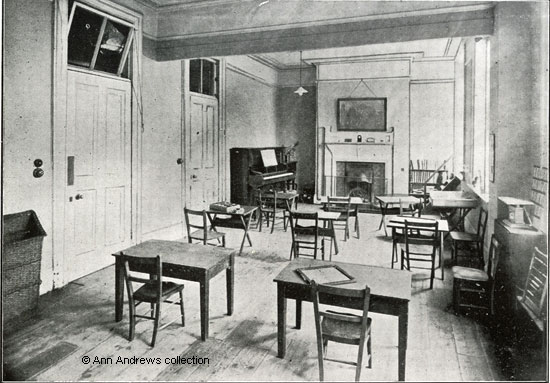"The Aim of the Matlock Modern School is to provide a sound
all-round education
on modern lines by promoting a healthful, happy, regular life,
combined with the
development off practical, cultured personality, based on the best
present-day
educational practice. The ultimate aim of education is kept in
view : to equip the
pupils adequately for their future, and so specialist attention
is given to
VOCATIONAL GUIDANCE AND PREPARATION
for definitive callings and professional careers, so that they
may eventually earn their own
living, or be able to do so, should the occasion arise."
This prospectus was produced a few years after the school moved
from Tor Cottage in Matlock Dale to its new home on Rutland Street
and the date of its publication has been worked out from information
about people mentioned in the text. Quotation marks indicate
quotes from the brochure.
The school was opened on 11th March
1926 by Sir Henry Hadow (late Vice-Chairman of Sheffield University
and Chairman of the Government Committee that issued the Hadow
Report). He declared that "Modern
education should give special attention to literature, music and
the arts and crafts ... [giving] the pupil, when leaving school,
a desire to learn more ... But whatever the subject, let their
standards be high ...".
The premises were described as "700 feet above sea level,
facing south, with magnificent views over the town and surrounding
country". The school was considered
to be in a healthy locality and its pupils were encouraged to lead
a healthy, outdoor life. "Special
attention is given to outdoor life with, as far as climate will
permit, open-air games and classes, including Nature Rambles, Camping,
Swimming in the Thermal Baths, Riding, Tennis Hockey, Cricket,
etc."
A sun-lamp, the first in the country in a private school, was
installed "for the promotion of sound physical development".
Its use was supervised by a trained nurse. The reason given was
that the U.K. receives too little sunlight.
The bedrooms were for two or three only - unsurprising as this
had been a hydro and would not have been designed with large dormitories
anyway. However, in the summer "there is excellent provision
for sleeping out of doors, on the beautiful balconies, for those
whose parents so desire".
Some single rooms were also available.
View from the front.
The school's name is on the wall above the south garden entrance.
The White Hall.
The ground floor plan at the bottom of the page shows that the
White Hall and the Dining Room were one and the same.
Upper Hall shewing Wireless Room.
"A Wireless Equipment has been installed and is used by
the staff and pupils for educational and entertainment purposes".
A classroom.
"The School Course includes Religious Knowledge, English Language
and Literature, History, Geography, Arithmetic and Mathematics,
French, Latin, Elementary Science, Public Speaking, Theory of
Music and Harmony, Class Singing, Drawing, Handicrafts, Plain
Needlework, Home Nursing, Gardening, and Games".
The Studio.
"A large studio is equipped for various handicrafts, including
Painting, Modelling, Poster Work, Woodwork, etc. There is a special
room for Woodcraft Work".
Dining Hall.
"Much attention has been paid to the subject of diet, which
includes plenty of fresh fruits, vegetables, green salads, eggs,
milk and other diet rich in the essential vitamins. The food, too,
is unlimited, as is necessary in the case of growing children".
Note the two unidentified members of staff at the far end of the
room, perhaps waiting to serve lunch.
 |
Continental Holiday - Locarno - Aug. 1927.
"An interesting feature of the School management is the organisation
of inexpensive School Holidays abroad, and by this means large
parties of the pupils and their parents, accompanied by the
Principal and Warden, have been taken in recent years to France, Belgium,
Holland, Switzerland and Italy. The pupils who wish to do so
secure camping equipment, take these with them to a carefully
selected site, and have a glorious time living in the open
air, visiting the neighbouring villages, shopping and conversing with
the people in the language of the country. These journeys give
the pupils a savoir faire and travel experience, an
added interest in languages, and self-reliance, all of which
is immensely beneficial and broadening. One year a party of
about thirty or forty pupils and parents visited Locarno on
the Swiss-Italian Lake Maggiore, where a charming camp holiday
was spent, including visits to the picturesque markets, bathing
in the lake, interesting excursions to the many beautiful places
on the lakes - Como, Lugano, Palanza, Isola-bella and Milan".
 |
Margaret Morris Dancing [Photo: Fred Daniels].
Dancing was taught by "a fully qualified resident Instructress
from the Margaret Morris Studios in London. ... Over 200 exercises
are carefully graded from the simplest to the most complex,
all with their appropriate music ... The exercises are carefully
graded and chosen to suit the individual, so that faults of
posture, etc., may be overcome. At the same time the exercises
are interesting to perform because they are all compositions
in movement, developing a natural grace through muscular control
and balance".
 |
An Outdoor Play.
"The ethical value and educational service of plays, and especially
of original productions among young people, have always been
recognised and practised at the School. Some original Plays, including
Mumming Plays, exceeding clever in construction and dialogue, and
effective in inculcating some ethical truth, have been written
by members of the staff, and produced and acted by pupils to large
audiences, usually in the grounds of the school".[1]

Some of the staff.
"Full recognition is given to the importance in these days
of meeting the requirements of modern conditions in the attainment
of a high standard of education, and academic success. Members
of the staff hold honours degrees".

Mrs. Law believed in the same principles as Margaret McMillan
(1860-1931) and such a warm recommendation must have pleased the
school's founder.
The words FRIEND TO ALL CHILDREN are inscribed
on Margaret McMillan's gravestone (external link).
 |
In the first week of September 1932 Sir W Arbuthnot Lane attended
the first Summer School of the New Health Society, held
at Matlock Modern School. He praised the school's methods and
equipment and thought the school "a fine example to others in its ways
and methods ... In this school they are trying to make healthy
girls who will make fine young women." He is third from
the right in the above photo. Mrs. Bertha Law is on the far
right and presumably her husband, Albert is standing between
the two. Also in the picture is the then Marchioness of Hartington
who presided over the event. The prospectus was written not
long afterwards.

The room opposite the Sanctuary was the Loquitorium (parlour).
Three images, showing the grounds, are not included here. |





















